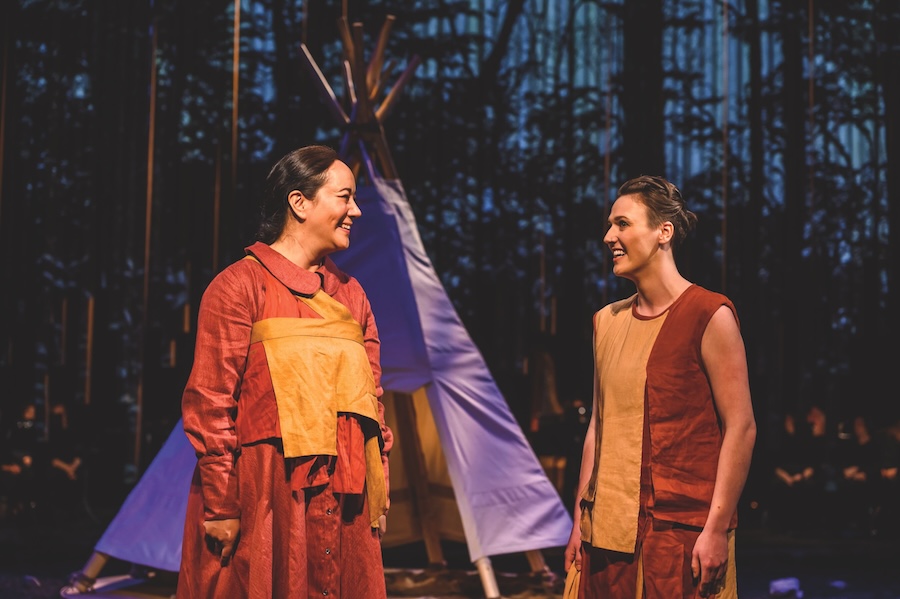When poet, librettist and scholar Suzanne Steele conceptualized Li Keur: Riel’s Heart of the North over six years ago, she had one goal in mind: to write an opera about Indigenous people for Indigenous people.
“I wrote a Métis opera, very clearly,” Steele says. “It had slower parts to it, which non-Indigenous people might find uncomfortable. It was filled with things that Indigenous people would recognize as being our own.” The first full-scale Indigenous opera presented on a Canadian mainstage, Li Keur celebrates Métis women and culture as it dramatizes a little-known love affair in the life of Métis leader Louis Riel.
You may unsubscribe from any of our newsletters at any time.
During its three-day run last November, the opera transformed Winnipeg’s Centennial Concert Hall. It welcomed Elders, who provided audience and performer support; it welcomed Indigenous artisans, who sold their wares in the atrium; and during the performance, it welcomed arias in the Métis languages Southern Michif and French Michif, as well as Anishinaabemowin, English and French.
Li Keur is one of a number of Indigenous operas that have taken stages across the country by storm in recent years. The landscape of Canadian opera is changing, and more Indigenous writers, composers and performers are creating works that tell their own stories and challenge the norms of the historically Eurocentric medium. With the backing of operatic institutions, the range of new works is poised to grow.
More on Broadview:
-
Lost records, found roots: How a Métis genealogist helps people uncover their Indigenous ancestry
-
Indigenous artist’s mural designs in Port Alberni church represent hope and healing
Composer Ian Cusson and author Cherie Dimaline, both Métis, are collaborating on an adaptation of Dimaline’s novel Empire of Wild, in partnership with the National Arts Centre in Ottawa. Cusson is also working on an operatic adaptation of Thomas King’s best-selling witty novel Indians on Vacation. And from coast to coast smaller scale productions are nurturing new Indigenous voices.
One of the artists leading the shift is mezzo-soprano Marion Newman. Like most students of opera, Newman began her introduction to the art by learning the western canon. The singer of Kwagiulth and Stó:lō First Nations heritage has scored prestigious roles in Carmen and The Barber of Seville. In 2017, Newman had the unique opportunity to perform in Gitxsan in Marie Clements’s opera, Missing.
The opera, which tells stories about missing and murdered Indigenous women in English and Gitxsan, was unlike any other production she’d performed in. “It’s really hard to rehearse something like that without feeling that story very deeply,” Newman says, especially “when you have family…who’ve gone through that.”
Anticipating the impact of the performance on Indigenous guests, Missing prompted a practice foreign to the Canadian opera world: audience care.
“There would be counsellors on-site during the show, as well as Indigenous carers and healers to smudge or say a prayer or just spend some quiet time with anybody in the audience who felt affected by the story,” she says.
The integration of audience care soon suggested the need for performer care, too. It is now a feature of many Indigenous operas, with Elders, smudging and prayer offered at productions like Li Keur.
Want to read more from Broadview? Consider subscribing to one of our newsletters.
Cole Alvis, a Métis theatre artist, had a uniquely Indigenous introduction to the opera world — one she stumbled upon by accident. Back in 2010, Alvis encountered a production management opportunity with Native Earth Performing Arts, Canada’s oldest Indigenous theatre company. “It just happened to be an opera written in Anishinaabemowin, French and English,” she says. “And for a period of time, the only operas I saw were Indigenous operas.”
Today, Alvis’s opera credits include performing in Louis Riel and co-directing Two Odysseys: Pimooteewin / Gállábártnit with Michael Greyeyes. While she says institutions and general audiences across Canada are beginning to develop “a discernment and a taste for Indigenous opera,” she believes there’s still a long way to go.
It’s something Steele has come to realize as well. When Indigenous practices arrive at an institution that is historically and structurally Eurocentric, clashes and contradictions are bound to arise. Li Keur’s stage management team, for example, was largely non-Indigenous and sometimes had different priorities for the show than the Indigenous theatre artists, says Steele.
The crew had to learn “that ceremony and prayer and good words and good relationships were number one — way more than everything being done right this minute, on time.”
After an incredibly successful run in Winnipeg, Li Keur lives on as a remarkable language revitalization feat. As a companion to the opera, the team produced an online database comprised of hundreds of audio and video recordings in Southern Michif, French Michif and Anishanaabemowin.
“You have to have authentic voices, which is why I had the languages,” Steele says. As performers worked alongside language keepers like Verna DeMontigny, Jules Chartrand and Donna Beach, rehearsals transformed into sites of linguistic reclamation.
Accordingly, the music had to follow suit. When Li Keur cocomposer and Métis fiddler Alex Kusturok wrote the instrumental accompaniment, he took inspiration from classics like the Red River Jig, a beloved Métis dance tune, rather than the western canon. “I wrote them in a way that I would play them for a dance to keep that authenticity,” he says. Instead of observing a baton, the orchestra followed Kusturok’s feet for conducting cues.
For Newman, singing in Gitxsan in Missing went beyond preserving narrative authenticity — it opened an entirely new world view for her.
“Here’s a language that’s been living so quietly among us that no one really knows what it sounds like,” Newman says. “As someone who was learning some of that language, it really helps you understand that language grows from where people are, as well as who people are, and that the sounds fit the space they were living in.”
Gitxsan, a language birthed by forest-dwelling people, is spoken in whispered tones, mirroring the wind blowing through cedar trees. “Gitxsan” translates to “People of the River Mist,” referring to their home on the Skeena River in present-day British Columbia.
When Indigenous operatic narratives are reduced to English in the name of catering to wider audiences, these nuances become lost in translation.
“Indigenous culture can’t be separated from the language,” Alvis says. “So while that is true in my family — there has been separation from our language and therefore our culture — there’s such power and potential when we return, when we bring ourselves to the language and therefore have more of an opportunity to be engaging with the world view.”
Newman’s future projects include starring in the operatic adaptation of Indians on Vacation. For her, the work speaks to a new era of the classical art form: one that welcomes Indigenous joy. “It makes my heart warm to know that we are telling a fuller story — not just the rough stuff, but the everyday, what it is to be a human,” Newman says.
“And the characters happen to be Indigenous.”
***
Cierra Bettens is a Red River Métis writer and editor in Winnipeg.
This article first appeared in Broadview’s June 2024 issue with the title “Arias of Growth.”














